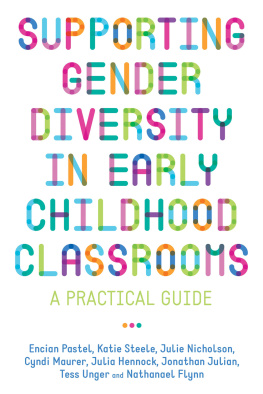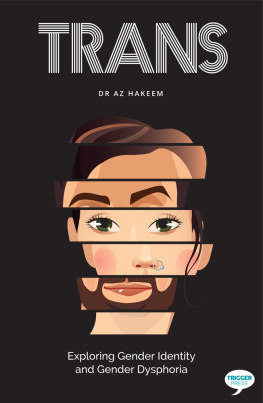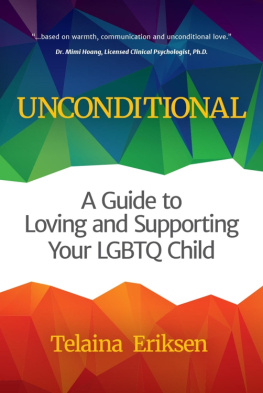
Supporting Gender
Diversity in Early
Childhood Classrooms
A Practical Guide
Encian Pastel, Katie Steele, Julie Nicholson,
Cyndi Maurer, Julia Hennock, Jonathan Julian,
Tess Unger, and Nathanael Flynn

Jessica Kingsley Publishers
London and Philadelphia
Contents
Introduction
Lucien is a five-year-old child in a preschool classroom in Northern California. Every day, Lucien comes to school wearing clothing marketed for boys, with commercial images of cars and spaceships and dinosaurs. Lucien enters the classroom and hangs a lunchbox emblazoned with images of starships and laser weapons, on its hook but they are hidden inside of a pink Barbie tote bag. This is how lunch comes to school every day.
Lucien then heads to the costume area. Every day, Lucien either covers or replaces the cars, dinosaurs, and spaceships with one of two outfits: a pink sparkly princess dress or a velvety leopard bodysuit. Lucien spends most of the day in costume until outside time, when costumes must remain in the classroom. Reluctantly, Lucien returns the pink sparkles or catsuit to the costume box.
Outside time is full of sand and water and dirt, and sometimes children come in for lunchtime needing to change into clean and dry clothing from their cubbies. One day, Lucien tells Teacher Heather, Mom forgot to put clothes in my cubby, so I need to borrow school clothes. Heather opens the closet and looks at the two extra clothes bins labeled Boys and Girls. Heather looks at Lucien for a moment, struggling a bit with which clothes Lucien would choose. She puts both bins on the table. For a moment, Lucien looks confused. Then, with eyes wide, Lucien asks: Icanchoose? Heather smiles and says, Yes, but lets do it quickly because lunch has already begun.
Lucien does not get dressed quickly.
Lucien tries on half a dozen combinations, asking Teacher Heather: Should I wear the rainbow pony shirt with the purple pants? Or the kitty leggings? Finally, Lucien settles on an outfit and, after a happy day of pretending to be sisters with best friend Emma, wears the clothes home. The next day, Luciens mom brings in the freshly laundered borrowed clothes, along with a stack from home for the Luciens cubby. They are all dinosaurs and cars and spaceships. After outside time, Heather sees Lucien stuff both the new, clean clothes from home and dirty clothes behind a bench. Teacher Heather, Lucien says happily, I dont have any clothes. Can I have school clothes again?
Maybe you picked up this book because you work with or know a child like Lucien. Most early childhood professionals are familiar with young children who blur gender lines, or defy them altogether. Maybe youre familiar with the term transgender and with thinking outside the box around gender norms and identities, but youre not quite sure how to do this in your childcare center. Perhaps you yourself are transgender, and you want to work towards making the preschool where you work more gender inclusive but dont know where to start. Or maybe this is your first genuine introduction to gender diversity, and youre really not sure where this book is going to take you. However, you found yourself here and whatever your level of familiarity with the subject, we hope to provide you with support and direction for making your early childhood environment a space where all children feel safe, seen, and respected for who they are.
Why do we need a book on supporting gender diversity in early childhood education?
The last few years have brought increasing visibility and media attention to the topic of gender diversity. There have been a range of newspaper articles and television shows aimed at increasing public awareness about the daily lives of transgender and gender expansive youth and adults with the idea that increased visibility will support greater understanding, empathy, and respect.
At the same time, there is still a stigma against breaking gender norms and rules. This stigma is reflected in several U.S. states passing or trying to pass legislation preventing transgender adults and students from using the restrooms most closely aligned with their identities. As of the writing of this book (October 2018), the U.S. federal government is working to define sex and gender as being strictly binary (male or female), dependent only on genitals or genetic testing done at birth, and unchangeable from a legal standpoint despite growing research that this kind of definition is insufficient and inaccurate in the U.S. Despite the increased attention, both positive and negative, the majority of the conversation about transgender identities offers little to no mention of the experiences of very young children even though our identities and our basic understandings of gender form as infants, toddlers, and preschoolers.
Many transgender and gender expansive adults report that they were aware of their feelings regarding gender as young as 23 years of age (Pyne, 2014). We also know that outpatient clinics specializing in working with transgender and gender expansive (TGE) children have seen referrals and client bases triple over the past 30 years (de Vries & Cohen-Kettenis, 2012; Keo-Meier & Ehrensaft, 2018; Zucker et al. , 2008).
Keo-Meier and Ehrensaft (2018) coined the acronym TGE children to refer to all children who challenge and explore gender identity and gender expressions (p. 8). TGE stands for transgender and/or gender expansive . Both of these terms are defined in the Gender Vocabulary section in .
Current efforts to support TGE children generally begin when they are in elementary school at the earliest but usually much later. Very little, if any, emphasis is given to the early childhood years (birth to five) when childrens gender awareness first emerges (Mallon & DeCrescenzo, 2006; Petty, 2010). In those first five years, children are developing awareness about how gender is understood in their families, communities, and society. These ideas will affect their understanding of gender throughout their lives including in their own identity development. (See section, Why Early Childhood is such an Important Time to Talk about Gender Diversity at the end of for a breakdown of developmental gender milestones by age, and corresponding research.)
Young TGE children are often in early learning programs with teachers, providers, and peers who do not understand their feelings about gender and the types of support, encouragement, acknowledgment, and respect they need in order to confidently be who they are. Early childhood professionals do not receive information in their coursework or professional development activities to help them understand TGE young children or how they can create gender inclusive environments that support the gender health of all children.
There is great urgency for early childhood teachers and providers to learn how to support gender diversity and gender health for all children and especially for TGE children. Why is this such an urgent need?
Transgender and gender expansive children are at a high risk for violence and self-harm. The ideas and actions of this book are grand, sweeping, and controversial. They involve significant amounts of personal and institutional work. The question will naturally arise as to why it is necessary. Why should you and your co-workers put in all this effort? We deeply believe that the real answer to this question is that it is simply the right thing to do. This work is how we can truly honor, support, and empower all young children. It is the right thing to do to trust children and to believe them when they tell us who they are, and that is enough reason for us. However, there is also a sadder truth and a more compelling reason for some to become engaged in this work, and that is the simple fact that children are being harmed by the way things currently are. Indeed, many children have been lost forever to rigid and binary gender rules and the ways our society enforces them.
Next page







